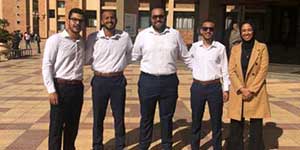Sponsorship of the Academy of Scientific Research and Technology 2023
The project of PUA’s Faculty of Engineering won the sponsorship of the Academy of Scientific Research and Technology for 2023. This project represents a joint scientific collaboration between students of the Mechanical Power Engineering Program and the Industrial and Manufacturing Engineering Program. It also comes within the framework of engineering and technological integration to design, manufacture and use modern technology in the production of dry ice and its applications.
The proposed project consists of two successive phases; The first is the process of producing dry ice from carbon dioxide. The second stage, however, begins with the use of snow pellets resulting from blasting and slapping as an operational process.
During the first stage, dry ice is produced in the form of small pellets of carbon dioxide by converting it under pressure and temperature of -78°C. this is done through a special design for pumping, pressing, and production in preparation for its use in the slapping process.
The second stage, which is the process of blasting and slapping with dry ice, represents one of the non-traditional methods of operation. It’s developed for cleaning and finishing internal and external surfaces with folds and complex and delicate structures such as medical devices, electronic and electrical devices, and inside many organic food factories. This process is safe, non-toxic, and leaves no by-products or odor. In addition to being electrically non-conductive, it also guarantees sterilization along with its original function.
One of the secondary advantages of the proposed project is its contribution to the foundations of sustainability based on controlling the climate cycle of the fumes of the petrochemical industries and others. The fumes emit huge amounts of carbon dioxide, which are collected to reduce the harmful effects due to their concentration in narrow geographical areas. At the same time, it adds to the gas a new useful life cycle while reducing its harmful effects by distributing it to larger areas in a random manner.









